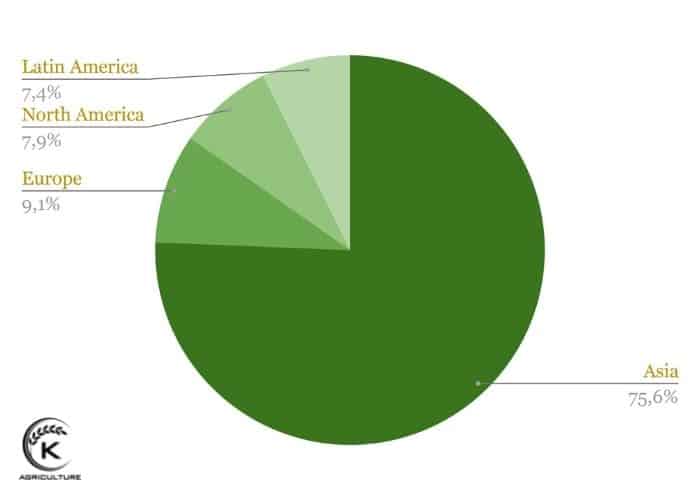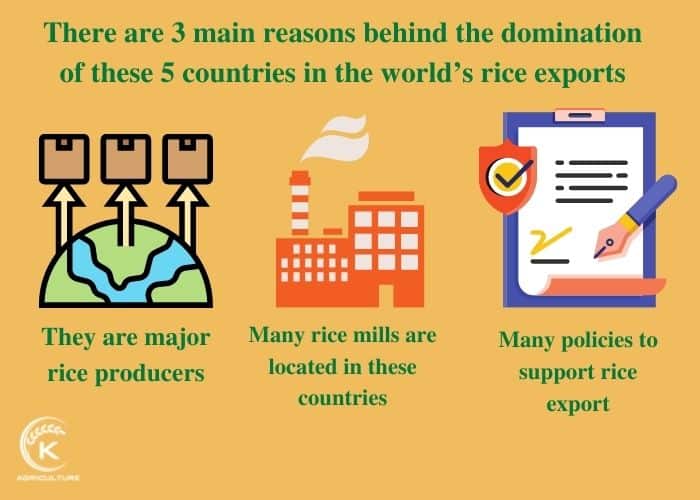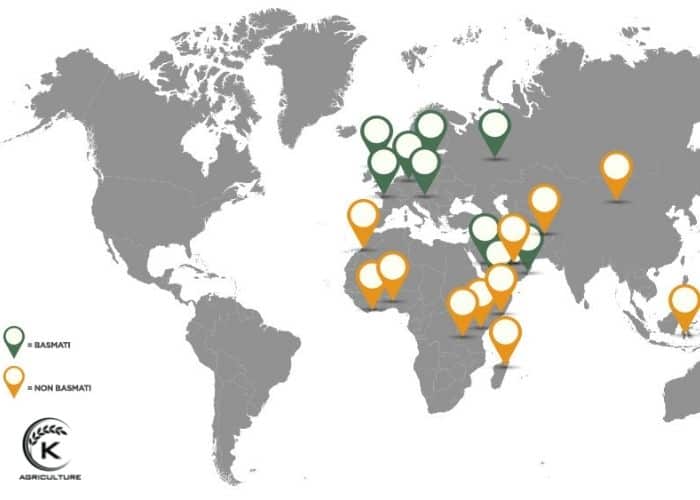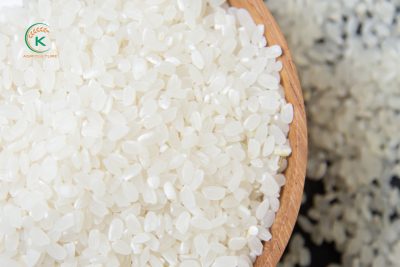Being the most important staple food, rice is exported to many destinations around the world. Talking about rice exports, people usually mention India, Thailand, Vietnam, Pakistan, and the USA as the major rice exporting countries.
Contents
An overview of rice exporting countries in the world
In 2020, the total rice export quantity was nearly 46 million tonnes, which was equal to USD 24.5 billion in value. Compared to 2019, an increase of 1.3% was recorded in the worldwide rice export volume.
Asia ranks first in terms of rice exports when this region accounts for 74.8% of the total. European countries provide 9%, followed by North America and Latin America, with 7.8% and 7.3%.
Read more: Overview of the wholesale rice market

Aisa accounts for the majority of the total rice exports
Top 5 rice exporting countries
With humid climate conditions, Southern Asia is the most suitable area for rice growth. This region is also the largest area of rice production. As a result, 4 out of 5 major rice exporting countries are from Southern Asia.

Top 5 rice exporting countries in 2020
There are 3 main reasons behind the domination of these 5 countries in the world’s rice exports.
- They are major rice producers. In 2020, India produced 118.8 million tonnes, followed by Vietnam and Thailand, with 27.1 and 17.66 million tonnes. With a huge rice production, these countries have the ability to satisfy both domestic and international demand.
- Many rice mills are located in these countries, with a considerably large capacity. For example, about 580 rice mills are located in the Mekong Delta in Vietnam, which can produce 10 thousand tonnes annually. Therefore, 90% of Vietnam’s total rice export is from this region.
- Many supporting policies for rice exports are established. For example, the Eurasian Economic Commission Council (EEC) has allocated import quotas for Vietnamese rice to each member country of the Eurasian Union (EAEU) in 2021. Specifically, for Belarus, the import quota is 96 thousand tonnes of Vietnamese rice, and 400 tonnes of Armenian rice.

3 reasons behind the domination of the 5 countries in rice export
An analysis of major rice exporting countries
Each nation has its own characteristics to become one of the leading rice exporting countries.
India
India ranks first among rice exporting countries in terms of volume and value. With its huge rice production capacity, 50% of the world’s wholesale rice volume is from India. Currently, Indian export rice costs from $350 to $370 per tonnes.
40% of India’s rice export is basmati rice, with 4 million tonnes exported in 2018. The country is one of the major rice exporting countries of basmati rice, accounting for 85% of the total world trade. Some countries in the Middle East such as Saudi Arabia, Iran, UAE, Iraq, and Kuwait are major import destinations of Indian basmati rice.

Basmati rice export from India
Besides, India is also well-known for non-Basmati rice with 9.7 million tonnes exported annually. India’s traditional import markets for non-basmati rice include Bangladesh, Senegal, and South Africa.

India exports both basmati and non-basmati rice
West Bengal is the largest rice basket in India, which contributes to 13.95% of the total rice volume produced. Uttar Pradesh and Punjab are other major areas, producing 13.75 million tonnes and 11.59 million tonnes respectively.
Being one of the major rice exporting countries, India has many advantages in terms of transportation and supply chains.
- In terms of geographical distance, India is right next to one of the world’s largest rice importers, Bangladesh, and to the West Asian and African markets than Vietnam. Therefore, transportation costs are often more affordable, especially during the epidemic situation when the cost of sea transportation increases in 2021.
- The stability of the Indian market lies in the large rice stockpile, nearly 50 million tons, ensuring that rice exports do not affect food security. This stability was brought into play in early 2020 when Southeast Asian rice exporting countries temporarily stopped their international supply chains due to concerns about the impact of the covid epidemic, India has won many orders.

India’s advantages in rice export
Vietnam
From 2009 until now, Vietnamese rice export volume reaches 4 million tons annually, peaking at 8 million tons in 2012. According to the General Department of Vietnam Customs, Vietnam exported 6.25 million tons of rice in 2020, worth 3.12 billion USD.
The process of rice for export at K-Agriculture company
Compared to 2019, 2020 rice exports were down 1.8% in quantity but up 11.2% in value. The rice export trend in Vietnam is to reduce export volume and increase the value, gradually focusing on high-end rice supply chains. Vietnamese rice recorded a 19.1% increase in export price, reaching $547 per tonne.

Vietnam – one of the leading rice exporting countries
The Philippines is the largest import market of Vietnamese rice when this country accounts for more than 35% of the total rice exports. 12 % of Vietnamese rice is exported to China.
The Mekong Delta is the main rice source in Vietnam, producing 25.2 million tonnes in the period of 2018-2019. This region is also the homeland of many famous rice varieties such as ST rice.
Trade agreements between Vietnam and other countries are the “levers” for the development of rice exports, turning Vietnam into one of the largest rice exporting countries. In particular, EVFTA allows Vietnam to export 80 thousand tons of rice to the EU annually, with a tax rate of 0%.

EVFTA opens an opportunity for Vietnam to export rice to the EU market
Thailand
Thailand is the third-largest rice exporting country in terms of output but second in terms of value. Thailand used to be the world’s largest rice exporter but was surpassed by India and Thailand in 2012. Thailand is known as the largest exporter of jasmine rice when 1.45 million tonnes are exported annually.
33% of Thai rice is distributed to the United States because this country is highly estimated in terms of the rice export market. Thailand also provides rice to China, Hong Kong, Canada, and Singapore.

Thailand ranks third in the list of the major rice exporting countries
Thailand is one of the rice exporting countries that have the highest rice export price, from 405 USD/ton to 749 USD/ton depending on specific rice types. This characteristic helps Thai rice’s value increase. However, some importers that prefer affordable prices such as China and the Philippines will buy Vietnamese rice instead.
Rice grows in many areas in Thailand, especially the Northeast. Ubon Ratchathani Province is the leading rice producer in Thailand.
Pakistan
Pakistan is a rice exporting country of basmati and non-basmati rice. Pakistani basmati rice has a high value for export so that its price is double that of non-basmati rice. However, none-basmati rice accounts for 75-80% of Pakistan’s total rice export. Sindh is the major rice producer in Pakistan, contributing to 39% of the nation’s total rice production quantity.
The import destinations of Pakistani basmati rice are the Middle East and the EU, in which the UAE is the largest importer in 2014 with 159, 3 thousand tons. In contrast, the majority of Pakistani non-basmati rice is distributed to Kenya with 431 thousand tons, Madagascar with 335 thousand tons, and China with 266 thousand tons in 2017-2018.

Pakistan’s importers of basmati and non-basmati rice
To ensure food security, the government of Pakistan regulates the rice export price for each variety. Particularly, a tonne of ordinary basmati costs $1300, IRRI-9 costs $1000/tonne, and IRRI-6 costs $750 per tonne.
Pakistan has a harvest advantage in terms of non-basmati rice. Pakistan’s main crop is in September, 1 month earlier than other rice exporting countries. Therefore, at this time, the prices of Pakistani rice for export will be better.
The United States
The United States ranks 5th in the list of the largest rice exporting countries in the world. The types of rice that are exported are mainly high-value varieties to the European markets such as rough rice, brown rice, parboiled rice, and fully-milled rice.
Many countries in Latin America such as Mexico and Haiti mainly import U.S rice in large quantities per year. Rice export price in the USA is around 530 USD/ton.

The USA is a major rice exporting countries
K-Agriculture Factory is one of the leading Vietnamese agricultural product suppliers. We offer whole Rice, Coffee, and Spices from Vietnam to 80 countries over the world with the highest quality and at the best price. Supported by the Ministry of Industry and Trade, K-Agriculture Factory is also a national project to introduce Vietnamese agricultural products to the international market.
For special discounts and free consultation, contact us now via
Email: info@k-agriculture.com
WhatsApp: +84855555837 (Ms. Kris)

K-Agriculture Factory – a piooner in supplying Vietnamese rice to the world









that’s a great article.